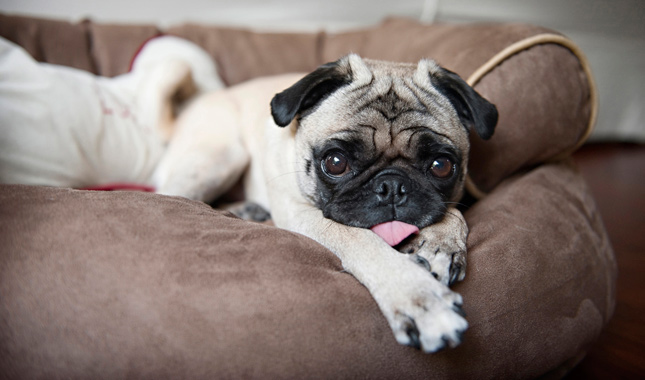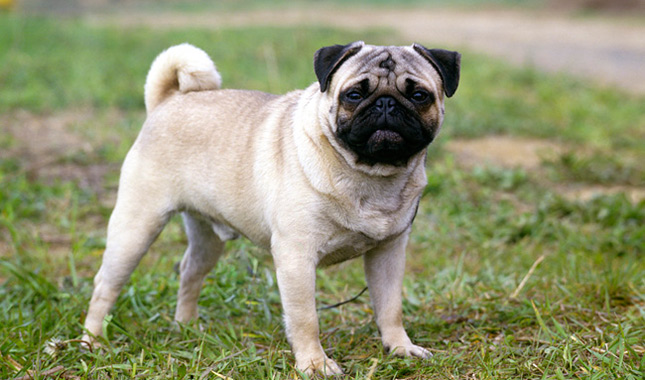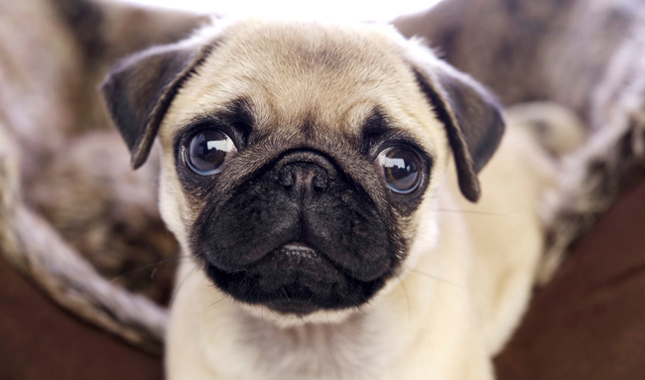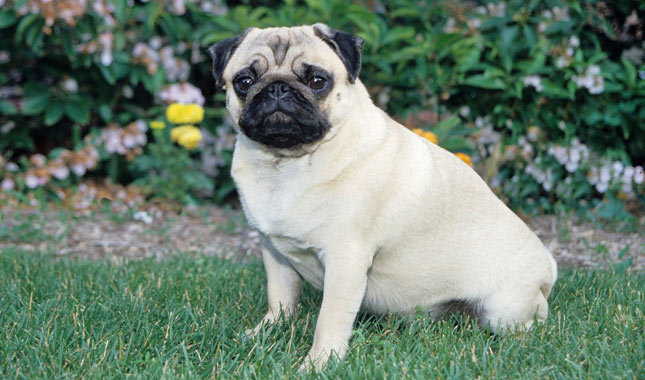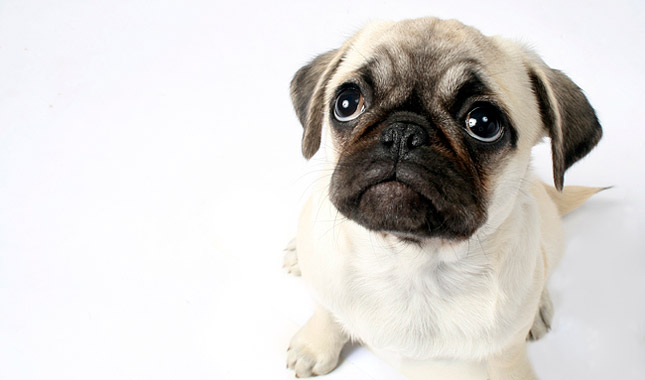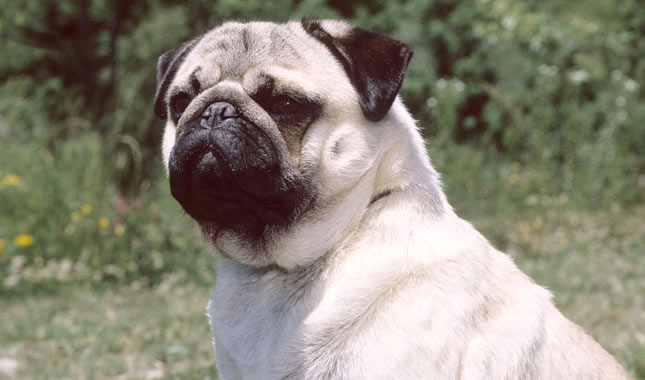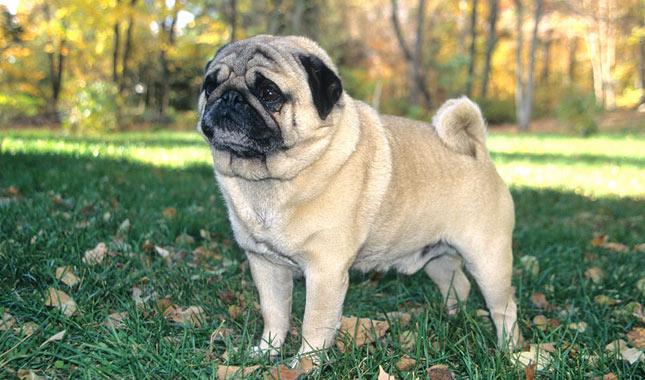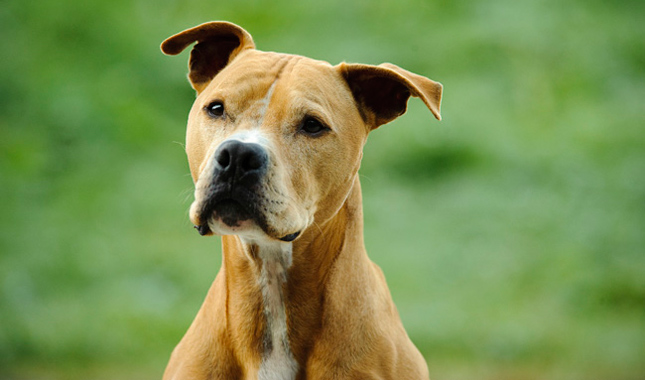Pug
Published on June 27, 2011
Skip To
Breed Details
- Height: Not specified in breed standard
- Weight: 14 to 18 pounds
Breed Characteristics
Adaptability
Trainability
Grooming
Apartament Friendly
Child Friendly
Shedding Level
Dog Friendly
Exercise Needs
Territorial
Barking Tendencies
Health Issues
Social Needs
Energy Level
Affectionate
Watchdog Instincts
Cat Friendly
Intelligence
Stranger Friendly
Round head, square body, curly tail — that’s the Pug. Wherever he goes, his wrinkly face and fun-loving personality charm people. He is good with other dogs, cats, and children, and nothing makes him happier than being part of the family. He’s no jogging buddy, but this lively fellow loves an outing to the office or park.Don’t let his worried, wrinkled little face fool you: The Pug is laughing inside. He’s laughing at you and with you — and he’s also trying to make you laugh. These dogs live for fun, which is the secret to their enduring popularity. Bred as companions for Chinese nobility, today they’re fulfilling their ancient function as beloved house pets. To their many admirers there is simply nothing like a Pug.
These are undeniably lovable dogs, bred for centuries for their wonderful dispositions. The Pug is never happier than when spending time with his human family, often following someone from room to room. He is welcome wherever he goes, with a handsome, smooth-coated frame in shades of tan, gray, and black, and with a black mask accenting his sweetly wrinkled face.
Pugs are usually good with other dogs, cats, and children. Bigger and hardier than many small-dog breeds, they can even withstand a bit more in the way of rough play, as long as it’s supervised and doesn’t get out of hand. Because of their relatively large size (for a toy breed) and easy-going temperament, they’re wonderful with children and perfect for on-the-go families, as long as they realize Pugs are not designed to be jogging companions or beach bunnies.
Compact and well-muscled with an endearing little ring of tail, a Pug should ideally weigh no more than 20 pounds. Many Pugs weigh more, owing to their begging skills. This trait too often leads to obesity, which can add to the already significant health burden these solid little dogs carry.
Lively, love-bug dispositions aside, the Pug has been bred to be much less healthy by the show-breeder’s focus on features such as a smaller size, flatter face, and overabundance of wrinkles. Heat-intolerance comes with the territory: Even temperatures as low as 80 degrees can be dangerous to these breathing-challenged dogs, which means a Pug must live indoors and have air conditioning available in all but the mildest summers. This is not a breed that can live outside.
If you’re careful to mind his special needs, the Pug is an easy-care pet. His short coat sheds, but his grooming needs are modest. He doesn’t need a great deal of exercise — nor can he tolerate it — but it’s important to keep him lean, fit, and mentally challenged, especially when he’s young. Because of his great love for people, care should be taken to accustom your Pug to being alone so he doesn’t develop excessive anxiety when left behind.
The American Kennel Club (AKC) began registering Pugs in 1885. Today, the Pug ranks 24th among the breeds registered by the AKC. That’s down somewhat from his 15th-place position in 2000, but it still puts him in the top 25, comfortably popular.
Pugs take well to training, too. That is, they will train you to spoil them appropriately. They love to eat, and it takes the strength of ten to resist a Pug’s pleading face when he wants one of your tater tots.
Pugs have a reputation for being difficult to housetrain. But if you learn to read their body language, they will tell you when they need to go out.
Is the Pug perfect? Well, no, not always. Any dog, no matter how nice, can develop obnoxious levels of barking, digging, food stealing, and other undesirable behaviors if he is bored, untrained, or unsupervised.
Start training your Pug puppy the day you bring him home. He is capable of soaking up everything you can teach him. Don’t wait until he is 6 months old to begin training or you will have a more headstrong dog to deal with. If possible, get him into puppy kindergarten class by the time he is 10 to 12 weeks old, and socialize, socialize, socialize. However, be aware that many puppy training classes require certain vaccines (like kennel cough) to be up to date, and many veterinarians recommend limited exposure to other dogs and public places until puppy vaccines (including rabies, distemper and parvovirus) have been completed. In lieu of formal training, you can begin training your puppy at home and socializing him among family and friends until puppy vaccines are completed.
Talk to the breeder, describe exactly what you’re looking for in a dog, and ask for assistance in selecting a puppy. Breeders see their puppies daily and can make uncannily accurate recommendations once they know something about your lifestyle and personality.
The perfect Pug doesn’t spring fully formed from the whelping box. He’s a product of his background and breeding. Whatever you want from a Pug, look for one whose parents have nice personalities and who has been well socialized from early puppyhood.
The Pug can develop certain health problems. Here’s a brief rundown on what you should know:
The Pug is prone to a condition called brachycephalic syndrome, characterized by pinched nostrils and an elongated soft palate. Because of it, Pugs can have breathing problems, especially in hot or humid weather or if their owners allow them to become overweight. It’s essential to keep Pugs cool, limit their exercise on hot days, and restrict the amount of food they eat so they can maintain a healthy weight. For Pugs who snore excessively or gasp for air, surgery can correct both the pinched nostrils and the elongated soft palate, but it’s up to breeders to improve the size of the nostrils so dogs can breathe properly.
A breed-specific disease called Pug Dog Encephalitis, or PDE, is an inflammation of the brain that causes seizures and death. There is no cure and no way to prevent the condition. The Pug Dog Club of America (PDCA) is aggressively supporting research into the cause of PDE, and there is now a test for the genetic marker for PDE. A good breeder will tell all prospective puppy buyers about any affected dogs in your puppy’s ancestry.
Orthopedic problems can occur, too. Like many small dogs, Pugs can have the hip deformity known as Legg-Calvé-Perthes disease, which reduces the blood supply to the head of the rear leg bone, causing it to degrade. According to a study published in the Journal of the American Animal Hospital Association in 2002, Pugs are at higher risk for Legg-Calvé-Perthes disease compared to many other dogs. The first sign of the disease, limping, usually appears when the puppy is 4 to 6 months old. It can be treated with surgery to remove the head of the leg bone, after which the puppy will have a relatively normal life other than an increased likelihood of arthritis.
Short-faced dogs, including Pugs, can be born with a spinal condition called hemivertebrae, in which the bones of the spine are deformed. Some Pugs have only minor deformities and don’t show any signs, while others develop a stagger; a weak, uncoordinated gait; or can become paralyzed. This usually occurs when a puppy is 4 to 6 months old. There are no screening tests for hemivertebrae.
Pug kneecaps often easily slip out of place, a condition known as luxating patellas. Sometimes the condition is minor and requires no action, but severe cases may require surgical correction.
Pugs often have serious dental problems because their teeth are crowded into their flattened faces. It may be necessary to have some retained puppy teeth pulled to allow room for permanent teeth to grow, and Pugs may need more frequent dental cleanings.
And even though he is classified as a Toy dog, the Pug can be predisposed to hip dysplasia. The incidence of HD in the breed is surprisingly high. But unlike in many large-breed dogs, Pugs with HD are less likely to need hip replacement surgery.
Pugs have a high incidence of a liver defect known as portosystemic shunt, which may need to be treated with expensive surgery.
Because Pugs have big eyes that protrude from the face, they are prone to eye injuries. Pugs can develop dry eyes, corneal ulcers, pigmentary keratitis, distichia (extra eyelashes that cause irritation) and entropion (a condition in which the eyelids curl inward and hairs on the outer eyelid can scratch and damage the cornea).
Not all of these conditions are detectable in a growing puppy, and it can be hard to predict whether an animal will be free of these maladies, which is why you must find a reputable breeder and insist on seeing independent certification that the parents of the dog (and grandparents, etc.) have been screened for these defects and deemed healthy for breeding. That’s where health registries come in.
The PDCA participates in the Canine Health Information Center, a health database. The CHIC tests required for Pugs to achieve registry are Orthopedic Foundation for Animals evaluations for hip dysplasia and patellar luxation at 2 years of age, the DNA test for PDE from the Veterinary Genetics Laboratory at the University of California at Davis, and a Canine Eye Registry Foundation exam every three years. A dog need not receive good or even passing scores on the evaluations to obtain a CHIC number, so CHIC registration alone is not proof of soundness or absence of disease, but all test results are posted on the CHIC website and can be accessed by anyone who wants to check the health of a puppy’s parents.
If a breeder tells you she doesn’t need to do those tests because she’s never had problems in her lines, her dogs have been vet checked, or any of the other excuses bad breeders have for skimping on the genetic testing of their dogs, walk away immediately.
Careful breeders screen their breeding dogs for genetic disease and breed only the healthiest and best-looking specimens, but sometimes Mother Nature has other ideas and a puppy develops one of these diseases despite good breeding practices. Advances in veterinary medicine mean that in most cases the dogs can still live good lives. If you’re getting a puppy, ask the breeder about the ages of the dogs in her lines and what they died of.
Will your Pug get any or all of these diseases? Not necessarily, but it’s smart to know the possibilities.
Remember that after you’ve taken a new puppy into your home, you have the power to protect him from one of the more common Pug health problems: obesity. The breed standard calls for the Pug to weigh a svelte 14 to 18 pounds, but it’s not unusual for some to reach twice that weight. Some of those larger Pugs are fit, but if you can’t see your Pug’s waist or feel (but not see) his ribs, it’s time for him to cut back on the snacks. Keeping a Pug at an appropriate weight is one of the easier ways to extend his life. Make the most of diet and exercise to help ensure a healthier dog for life.
The Pug’s facial wrinkles, especially the deep nose roll, must be cleaned. Each Pug is an individual, so you may have to clean them daily or only weekly. Wipe out the crud with a dampened cosmetic sponge or baby wipe, then thoroughly dry the wrinkles so they don’t mildew or become infected, a condition known to Pug people as “swamp face.”
Bathe the Pug as needed. With the gentle dog shampoos available now, you can bathe a Pug weekly if you want without harming his coat.
The rest is basic care. Trim the nails every week or two, and brush his teeth often — with a vet-approved pet toothpaste — for good overall health and fresh breath.
Good breeders will welcome your questions about temperament, health clearances, and what the dogs are like to live with, and come right back at you with questions of their own about what you’re looking for in a dog and what kind of life you can provide for him. A good breeder can tell you about the history of the breed, explain why one puppy is considered pet quality while another is not, and discuss what health problems affect the breed and the steps she takes take to avoid those problems.
Start your search at the website of the Pug Dog Club of America. Its code of ethics specifies that members must never sell their puppies to or through pet stores, and it maintains a breeder referral service and tips on finding a healthy, well-bred puppy.
Look for a breeder who is active in her national breed club and a local club, too, if possible. She should regularly participate with her dogs in some form of organized canine activities, such as showing, obedience, or therapy dog programs. She should sell her puppies with written contracts guaranteeing she’ll take the dogs back if at any time during their lives the owners cannot keep them.
Ask the breeder to provide you with documentation that your prospective puppy’s parents were cleared for hip and elbow dysplasia by the Orthopedic Foundation for Animals and for eye problems by the Canine Eye Registry Foundation (CERF). Hip clearance by the University of Pennsylvania (PennHip) is also acceptable.
Avoid breeders who seem interested only in how quickly they can unload a puppy on you and whether your credit card will go through. You should also bear in mind that buying a puppy from a website that offers to ship your dog to you immediately can be a risky venture, as it leaves you no recourse if what you get isn’t exactly what you expected. Put at least as much effort into researching your puppy as you would into choosing a new car or expensive appliance. It will save you money in the long run.
Lots of reputable breeders have websites, so how can you tell who’s good and who’s not? Red flags include puppies always being available, multiple litters on the premises, having your choice of any puppy, and the ability to pay online with a credit card. Quickie online purchases are convenient, but they are almost never associated with reputable breeders.
Whether you’re planning to get your new best friend from a breeder, a pet store, or another source, don’t forget that old adage “let the buyer beware”. Disreputable breeders and facilities that deal with puppy mills can be hard to distinguish from reliable operations. There’s no 100 percent guaranteed way to make sure you’ll never purchase a sick puppy, but researching the breed (so you know what to expect), checking out the facility (to identify unhealthy conditions or sick animals), and asking the right questions can reduce the chances of heading into a disastrous situation. And don’t forget to ask your veterinarian, who can often refer you to a reputable breeder, breed rescue organization, or other reliable source for healthy puppies.
And before you decide to buy a puppy, consider whether an adult Pug might better suit your needs and lifestyle. Puppies are loads of fun, but they require a lot of time and effort before they grow up to become the dog of your dreams. An adult Pug may already have some training and will probably be less active, destructive, and demanding than a puppy. With an adult, you know more about what you’re getting in terms of personality and health and you can find adults through breeders or shelters. If you are interested in acquiring an older dog through breeders, ask them about purchasing a retired show dog or if they know of an adult dog who needs a new home. If you want to adopt a dog, read the advice below on how to do that.
1. Use the Web
Sites like Petfinder.com and Adopt-a-Pet.com can have you searching for a Pug in your area in no time flat. The site allows you to be very specific in your requests (housetraining status, for example) or very general (all the Pugs available on Petfinder across the country). AnimalShelter.org can help you find animal rescue groups in your area. Also some local newspapers have “pets looking for homes” sections you can review.
Social media is another great way to find a dog. Post on your Facebook page that you are looking for a specific breed so that your entire community can be your eyes and ears.
2. Reach Out to Local Experts
Start talking with all the pet pros in your area about your desire for a Pug. That includes vets, dog walkers, and groomers. When someone has to make the tough decision to give up a dog, that person will often ask her own trusted network for recommendations.
3. Talk to Breed Rescue
Most people who love Pugs love all Pugs. That’s why breed clubs have rescue organizations devoted to taking care of homeless dogs. The Pug Dog Club of America can help you find a dog that may be the perfect companion for your family. You can also search online for other Pug rescues in your area.
The great thing about breed rescue groups is that they tend to be very upfront about any health conditions the dogs may have and are a valuable resource for advice. They also often offer fostering opportunities so, with training, you could bring a Pug home for a trial to see what the experience is like.
4. Key Questions to Ask
You now know the things to discuss with a breeder, but there are also questions you should discuss with shelter or rescue group staff or volunteers before you bring home a pup. These include:
Puppy or adult, a breeder purchase or a rescue, take your Pug to your veterinarian soon after adoption. Your veterinarian will be able to spot problems and will work with you to set up a preventive regimen that will help you avoid many health issues.
These are undeniably lovable dogs, bred for centuries for their wonderful dispositions. The Pug is never happier than when spending time with his human family, often following someone from room to room. He is welcome wherever he goes, with a handsome, smooth-coated frame in shades of tan, gray, and black, and with a black mask accenting his sweetly wrinkled face.
Pugs are usually good with other dogs, cats, and children. Bigger and hardier than many small-dog breeds, they can even withstand a bit more in the way of rough play, as long as it’s supervised and doesn’t get out of hand. Because of their relatively large size (for a toy breed) and easy-going temperament, they’re wonderful with children and perfect for on-the-go families, as long as they realize Pugs are not designed to be jogging companions or beach bunnies.
Compact and well-muscled with an endearing little ring of tail, a Pug should ideally weigh no more than 20 pounds. Many Pugs weigh more, owing to their begging skills. This trait too often leads to obesity, which can add to the already significant health burden these solid little dogs carry.
Lively, love-bug dispositions aside, the Pug has been bred to be much less healthy by the show-breeder’s focus on features such as a smaller size, flatter face, and overabundance of wrinkles. Heat-intolerance comes with the territory: Even temperatures as low as 80 degrees can be dangerous to these breathing-challenged dogs, which means a Pug must live indoors and have air conditioning available in all but the mildest summers. This is not a breed that can live outside.
If you’re careful to mind his special needs, the Pug is an easy-care pet. His short coat sheds, but his grooming needs are modest. He doesn’t need a great deal of exercise — nor can he tolerate it — but it’s important to keep him lean, fit, and mentally challenged, especially when he’s young. Because of his great love for people, care should be taken to accustom your Pug to being alone so he doesn’t develop excessive anxiety when left behind.
Other Quick Facts
- The Pug is among the largest of the Toy breeds.
- He’s lively and loves everyone, and his alert nature makes him an excellent watchdog.
- This breed snores and snorts, a by-product of his flat face. Learn to think of the noise as a lullaby.
The History of Pugs
Pugs probably originated in China, but not much is known about their early history. Experts believe that the short-coated, wrinkle-faced dogs were brought to Holland by Portuguese traders in the 16th century. They became popular in the Dutch royal court and made their way to England in 1689 when Dutch rulers William and Mary took over the English throne after the overthrow of Mary’s father, James II. Ever since, Pugs have been popular with rulers and the rich and famous. Among their admirers were King Louis XIV; Josephine, empress to Napoleon; Queen Victoria; the Duke and Duchess of Windsor; and fashion designer Valentino.The American Kennel Club (AKC) began registering Pugs in 1885. Today, the Pug ranks 24th among the breeds registered by the AKC. That’s down somewhat from his 15th-place position in 2000, but it still puts him in the top 25, comfortably popular.
Pug Temperament and Personality
People may initially be attracted by the Pug’s unusual appearance, but they are quickly won over by his personality. He is a charming, fun-loving clown of a dog who doesn’t mind wearing a costume. It’s all in good fun, after all. Even dressed as a bumblebee, the Pug has a knack for retaining his dignity even while making people laugh.Pugs take well to training, too. That is, they will train you to spoil them appropriately. They love to eat, and it takes the strength of ten to resist a Pug’s pleading face when he wants one of your tater tots.
Pugs have a reputation for being difficult to housetrain. But if you learn to read their body language, they will tell you when they need to go out.
Is the Pug perfect? Well, no, not always. Any dog, no matter how nice, can develop obnoxious levels of barking, digging, food stealing, and other undesirable behaviors if he is bored, untrained, or unsupervised.
Start training your Pug puppy the day you bring him home. He is capable of soaking up everything you can teach him. Don’t wait until he is 6 months old to begin training or you will have a more headstrong dog to deal with. If possible, get him into puppy kindergarten class by the time he is 10 to 12 weeks old, and socialize, socialize, socialize. However, be aware that many puppy training classes require certain vaccines (like kennel cough) to be up to date, and many veterinarians recommend limited exposure to other dogs and public places until puppy vaccines (including rabies, distemper and parvovirus) have been completed. In lieu of formal training, you can begin training your puppy at home and socializing him among family and friends until puppy vaccines are completed.
Talk to the breeder, describe exactly what you’re looking for in a dog, and ask for assistance in selecting a puppy. Breeders see their puppies daily and can make uncannily accurate recommendations once they know something about your lifestyle and personality.
The perfect Pug doesn’t spring fully formed from the whelping box. He’s a product of his background and breeding. Whatever you want from a Pug, look for one whose parents have nice personalities and who has been well socialized from early puppyhood.
What You Need to Know About Pug Health
All dogs have the potential to develop genetic health problems, just as all people have the potential to inherit a particular disease. Run, don’t walk, from any breeder who does not offer a health guarantee on her puppies, who tells you that the breed is 100 percent healthy and has no known problems, or who tells you that her puppies are isolated from the main part of the household for health reasons. A reputable breeder will be honest and open about health problems in the breed and the incidence with which they occur in her lines.The Pug can develop certain health problems. Here’s a brief rundown on what you should know:
The Pug is prone to a condition called brachycephalic syndrome, characterized by pinched nostrils and an elongated soft palate. Because of it, Pugs can have breathing problems, especially in hot or humid weather or if their owners allow them to become overweight. It’s essential to keep Pugs cool, limit their exercise on hot days, and restrict the amount of food they eat so they can maintain a healthy weight. For Pugs who snore excessively or gasp for air, surgery can correct both the pinched nostrils and the elongated soft palate, but it’s up to breeders to improve the size of the nostrils so dogs can breathe properly.
A breed-specific disease called Pug Dog Encephalitis, or PDE, is an inflammation of the brain that causes seizures and death. There is no cure and no way to prevent the condition. The Pug Dog Club of America (PDCA) is aggressively supporting research into the cause of PDE, and there is now a test for the genetic marker for PDE. A good breeder will tell all prospective puppy buyers about any affected dogs in your puppy’s ancestry.
Orthopedic problems can occur, too. Like many small dogs, Pugs can have the hip deformity known as Legg-Calvé-Perthes disease, which reduces the blood supply to the head of the rear leg bone, causing it to degrade. According to a study published in the Journal of the American Animal Hospital Association in 2002, Pugs are at higher risk for Legg-Calvé-Perthes disease compared to many other dogs. The first sign of the disease, limping, usually appears when the puppy is 4 to 6 months old. It can be treated with surgery to remove the head of the leg bone, after which the puppy will have a relatively normal life other than an increased likelihood of arthritis.
Short-faced dogs, including Pugs, can be born with a spinal condition called hemivertebrae, in which the bones of the spine are deformed. Some Pugs have only minor deformities and don’t show any signs, while others develop a stagger; a weak, uncoordinated gait; or can become paralyzed. This usually occurs when a puppy is 4 to 6 months old. There are no screening tests for hemivertebrae.
Pug kneecaps often easily slip out of place, a condition known as luxating patellas. Sometimes the condition is minor and requires no action, but severe cases may require surgical correction.
Pugs often have serious dental problems because their teeth are crowded into their flattened faces. It may be necessary to have some retained puppy teeth pulled to allow room for permanent teeth to grow, and Pugs may need more frequent dental cleanings.
And even though he is classified as a Toy dog, the Pug can be predisposed to hip dysplasia. The incidence of HD in the breed is surprisingly high. But unlike in many large-breed dogs, Pugs with HD are less likely to need hip replacement surgery.
Pugs have a high incidence of a liver defect known as portosystemic shunt, which may need to be treated with expensive surgery.
Because Pugs have big eyes that protrude from the face, they are prone to eye injuries. Pugs can develop dry eyes, corneal ulcers, pigmentary keratitis, distichia (extra eyelashes that cause irritation) and entropion (a condition in which the eyelids curl inward and hairs on the outer eyelid can scratch and damage the cornea).
Not all of these conditions are detectable in a growing puppy, and it can be hard to predict whether an animal will be free of these maladies, which is why you must find a reputable breeder and insist on seeing independent certification that the parents of the dog (and grandparents, etc.) have been screened for these defects and deemed healthy for breeding. That’s where health registries come in.
The PDCA participates in the Canine Health Information Center, a health database. The CHIC tests required for Pugs to achieve registry are Orthopedic Foundation for Animals evaluations for hip dysplasia and patellar luxation at 2 years of age, the DNA test for PDE from the Veterinary Genetics Laboratory at the University of California at Davis, and a Canine Eye Registry Foundation exam every three years. A dog need not receive good or even passing scores on the evaluations to obtain a CHIC number, so CHIC registration alone is not proof of soundness or absence of disease, but all test results are posted on the CHIC website and can be accessed by anyone who wants to check the health of a puppy’s parents.
If a breeder tells you she doesn’t need to do those tests because she’s never had problems in her lines, her dogs have been vet checked, or any of the other excuses bad breeders have for skimping on the genetic testing of their dogs, walk away immediately.
Careful breeders screen their breeding dogs for genetic disease and breed only the healthiest and best-looking specimens, but sometimes Mother Nature has other ideas and a puppy develops one of these diseases despite good breeding practices. Advances in veterinary medicine mean that in most cases the dogs can still live good lives. If you’re getting a puppy, ask the breeder about the ages of the dogs in her lines and what they died of.
Will your Pug get any or all of these diseases? Not necessarily, but it’s smart to know the possibilities.
Remember that after you’ve taken a new puppy into your home, you have the power to protect him from one of the more common Pug health problems: obesity. The breed standard calls for the Pug to weigh a svelte 14 to 18 pounds, but it’s not unusual for some to reach twice that weight. Some of those larger Pugs are fit, but if you can’t see your Pug’s waist or feel (but not see) his ribs, it’s time for him to cut back on the snacks. Keeping a Pug at an appropriate weight is one of the easier ways to extend his life. Make the most of diet and exercise to help ensure a healthier dog for life.
The Basics of Pug Grooming
Grooming a Pug’s coat is easy. Brush his smooth double coat weekly with a rubber curry brush to remove dead hair. And you will remove lots of it, because Pugs shed. A lot. They shed year-round, so it’s something you should expect to live with.The Pug’s facial wrinkles, especially the deep nose roll, must be cleaned. Each Pug is an individual, so you may have to clean them daily or only weekly. Wipe out the crud with a dampened cosmetic sponge or baby wipe, then thoroughly dry the wrinkles so they don’t mildew or become infected, a condition known to Pug people as “swamp face.”
Bathe the Pug as needed. With the gentle dog shampoos available now, you can bathe a Pug weekly if you want without harming his coat.
The rest is basic care. Trim the nails every week or two, and brush his teeth often — with a vet-approved pet toothpaste — for good overall health and fresh breath.
Finding a Pug
Whether you want to go with a breeder or get your dog from a shelter or rescue, here are some things to keep in mind.Choosing a Pug Breeder
Finding a good breeder is a great way to find the right puppy. A good breeder will match you with the right puppy and will, without question, have done all the health certifications necessary to screen out health problems as much as possible. She is more interested in placing pups in the right homes than making big bucks.Good breeders will welcome your questions about temperament, health clearances, and what the dogs are like to live with, and come right back at you with questions of their own about what you’re looking for in a dog and what kind of life you can provide for him. A good breeder can tell you about the history of the breed, explain why one puppy is considered pet quality while another is not, and discuss what health problems affect the breed and the steps she takes take to avoid those problems.
Start your search at the website of the Pug Dog Club of America. Its code of ethics specifies that members must never sell their puppies to or through pet stores, and it maintains a breeder referral service and tips on finding a healthy, well-bred puppy.
Look for a breeder who is active in her national breed club and a local club, too, if possible. She should regularly participate with her dogs in some form of organized canine activities, such as showing, obedience, or therapy dog programs. She should sell her puppies with written contracts guaranteeing she’ll take the dogs back if at any time during their lives the owners cannot keep them.
Ask the breeder to provide you with documentation that your prospective puppy’s parents were cleared for hip and elbow dysplasia by the Orthopedic Foundation for Animals and for eye problems by the Canine Eye Registry Foundation (CERF). Hip clearance by the University of Pennsylvania (PennHip) is also acceptable.
Avoid breeders who seem interested only in how quickly they can unload a puppy on you and whether your credit card will go through. You should also bear in mind that buying a puppy from a website that offers to ship your dog to you immediately can be a risky venture, as it leaves you no recourse if what you get isn’t exactly what you expected. Put at least as much effort into researching your puppy as you would into choosing a new car or expensive appliance. It will save you money in the long run.
Lots of reputable breeders have websites, so how can you tell who’s good and who’s not? Red flags include puppies always being available, multiple litters on the premises, having your choice of any puppy, and the ability to pay online with a credit card. Quickie online purchases are convenient, but they are almost never associated with reputable breeders.
Whether you’re planning to get your new best friend from a breeder, a pet store, or another source, don’t forget that old adage “let the buyer beware”. Disreputable breeders and facilities that deal with puppy mills can be hard to distinguish from reliable operations. There’s no 100 percent guaranteed way to make sure you’ll never purchase a sick puppy, but researching the breed (so you know what to expect), checking out the facility (to identify unhealthy conditions or sick animals), and asking the right questions can reduce the chances of heading into a disastrous situation. And don’t forget to ask your veterinarian, who can often refer you to a reputable breeder, breed rescue organization, or other reliable source for healthy puppies.
And before you decide to buy a puppy, consider whether an adult Pug might better suit your needs and lifestyle. Puppies are loads of fun, but they require a lot of time and effort before they grow up to become the dog of your dreams. An adult Pug may already have some training and will probably be less active, destructive, and demanding than a puppy. With an adult, you know more about what you’re getting in terms of personality and health and you can find adults through breeders or shelters. If you are interested in acquiring an older dog through breeders, ask them about purchasing a retired show dog or if they know of an adult dog who needs a new home. If you want to adopt a dog, read the advice below on how to do that.
Adopting a Dog From a Pug Rescue or Shelter
There are many great options available if you want to adopt a dog from an animal shelter or breed rescue organization. Here is how to get started.1. Use the Web
Sites like Petfinder.com and Adopt-a-Pet.com can have you searching for a Pug in your area in no time flat. The site allows you to be very specific in your requests (housetraining status, for example) or very general (all the Pugs available on Petfinder across the country). AnimalShelter.org can help you find animal rescue groups in your area. Also some local newspapers have “pets looking for homes” sections you can review.
Social media is another great way to find a dog. Post on your Facebook page that you are looking for a specific breed so that your entire community can be your eyes and ears.
2. Reach Out to Local Experts
Start talking with all the pet pros in your area about your desire for a Pug. That includes vets, dog walkers, and groomers. When someone has to make the tough decision to give up a dog, that person will often ask her own trusted network for recommendations.
3. Talk to Breed Rescue
Most people who love Pugs love all Pugs. That’s why breed clubs have rescue organizations devoted to taking care of homeless dogs. The Pug Dog Club of America can help you find a dog that may be the perfect companion for your family. You can also search online for other Pug rescues in your area.
The great thing about breed rescue groups is that they tend to be very upfront about any health conditions the dogs may have and are a valuable resource for advice. They also often offer fostering opportunities so, with training, you could bring a Pug home for a trial to see what the experience is like.
4. Key Questions to Ask
You now know the things to discuss with a breeder, but there are also questions you should discuss with shelter or rescue group staff or volunteers before you bring home a pup. These include:
- What is his energy level?
- How is he around other animals?
- How does he respond to shelter workers, visitors, and children?
- What is his personality like?
- What is his age?
- Is he housetrained?
- Has he ever bitten or hurt anyone that they know of?
- Are there any known health issues?
Puppy or adult, a breeder purchase or a rescue, take your Pug to your veterinarian soon after adoption. Your veterinarian will be able to spot problems and will work with you to set up a preventive regimen that will help you avoid many health issues.

